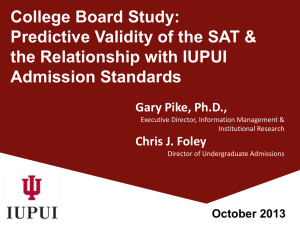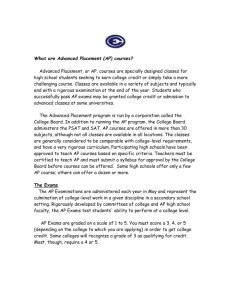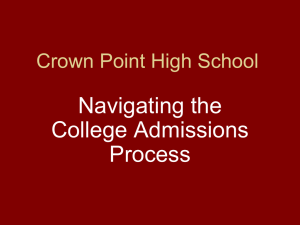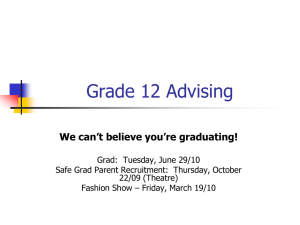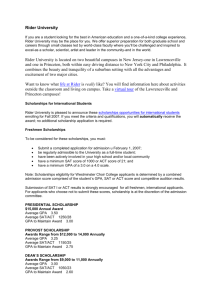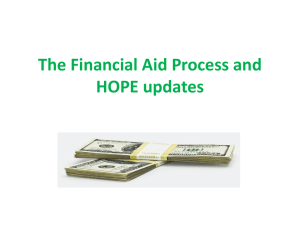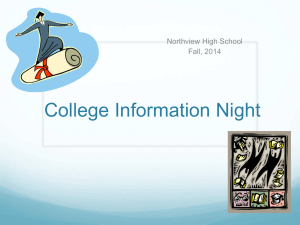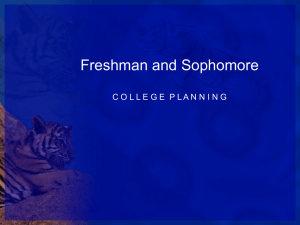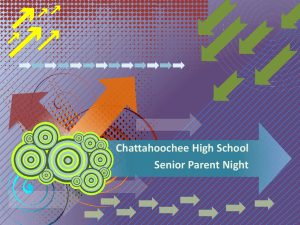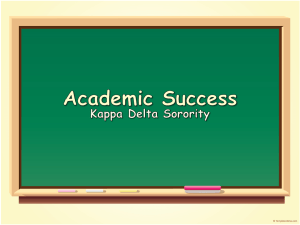View application
advertisement
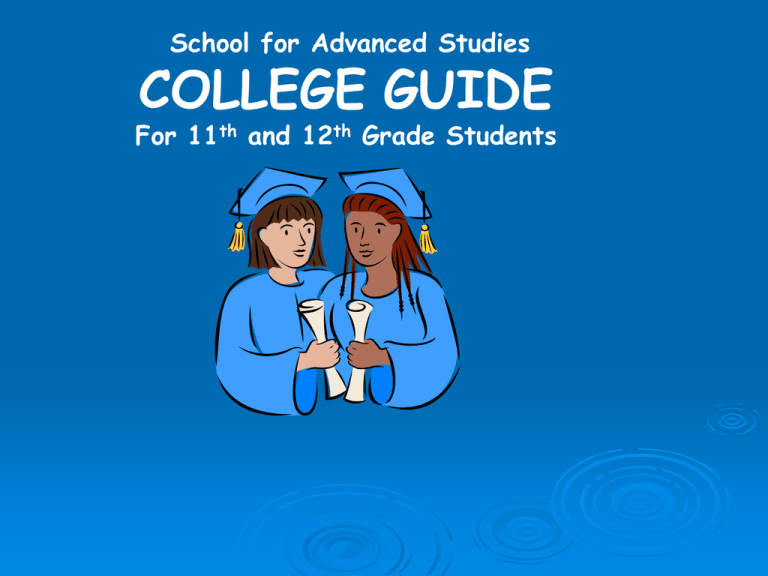
School for Advanced Studies COLLEGE GUIDE For 11th and 12th Grade Students The Importance of GRADES Do you have what it takes? Institutional Matrix SUS Admissions Tour as of September, 2012 FAMU FAU FGCU FIU FSU NCF UCF UF UNF USF UWF Summer 2.5 To 2.99 3.11 To 3.62 3.01 To 3.58 3.20 To 3.80 3.5 To 4.0 No Summer 3.4 To 3.9 3.90 To 4.30 3.22 To 3.80 3.50 To 3.80 2.70 To 3.30 Fall 3.0 To 3.49 3.35 To 3.95 3.06 To 3.72 3.50 To 4.10 3.70 To 4.30 3.73 To 4.33 3.5 To 4.2 4.1 To 4.5 3.51 To 4.21 3.97 To 4.27 3.00 To 3.80 2012 GPA 2012 GPA How can you improve your chances of success? • State Universities will recalculate your grades based on the following 18 Academic credits: 4 English, 4 Math (Algebra & above), 3 Social Sciences, 3 Natural Sciences, 2 Foreign languages; plus additional courses in the above subject areas • Focus your study efforts on your core academic classes • Challenge yourself with Honors and AP classes • Seek grade forgiveness in those classes that you earn a “D” or “F” in. • Know your recalculated GPA by going to www.FACTS.org > “high school students” > “Check Bright Futures Scholarship Eligibility” Grade Forgiveness and GPA Recalculation differs by Institution The Importance of Test Scores How can you improve your chances of success? Test Early Test Often Consider taking the ACT Seniors, (Juniors after 12/1) SAT and ACT test Fee Waivers are now available. If you are on free or reduced lunch, you qualify for the following. Remember that you must reapply each year to remain eligible. 2 ACT test waiver 2 SAT test fee waivers 4 College Board - College Application Fee Waivers Waivers used during your junior year count You will loose the fee waiver if you do not use it To receive a waiver, please see the test chairperson at your SAS site anytime before school, during lunch or after school. Find the Right Fit Academic Reputation (quality education) Availability of scholarship and financial aid How and when are scholarship awards made and when is notification received College Size Location Majors Faculty to Student ratio Job Placement success Colleges That Meet Full Demonstrated Need Colleges That Meet Full Demonstrated Need Continued… College Board: Big Future https://bigfuture.collegeboard.org/college-search College Summary SAT/ACT mid-ranges Financial Viability Amherst College Williams College Estimated Total $59,660 Estimated Total $59,712 Boston University vs Boston College Boston University Boston College Connect.edu Tools for Students Interactive Planning Tools Course Planner & Credit Checker Test Prep Information & Test Dates Financial Aid Information & Critical Dates College Budget & Cost Calculators Scholarships Search & Applications Profile & Resume Building Communication Tools Email Counselors, Students, & Parents Host & Track Student Events Send Scholarship & Events Notifications Page 16 College Search Tools Customized College Search College List Collaboration 4,300+ Searchable College Profiles Side-by-Side College Comparisons Acceptance History Scattergrams Centralized Student Tracking SuperAPP Application Processing Complete Application Tracking Electronic Transcript Requests Student Home Page Page 17 Research Colleges & Create a College List Page 18 What Colleges Look for When Making Decisions Top 3 Most Important Factors 1. Strength of curriculum (Honors, Advanced Placement, Dual Enrollment) 2. Grade Point Average (GPA) and class percentile 3. College Entrance Examination Scores (ACT or SAT) If the college requires them: Essay Interview Recommendation Letters Resume (leadership, community service, extracurricular, talents, etc) The Application Process Determine the number of schools to which you want to apply Be mindful of deadlines Treat this as a homework project – care should be given to the appearance of your application Determine if you want to complete the on-line application form If essay required, give it proper attention Decide on no more than 3 – 5 institutions Time line for decisions- DEADLINES Application Strategies APPLY EARLY: At the beginning of the admission cycle (August, September, and October) GPA and test score mid-ranges are typically low due to the low volume of application usually received at institutions with ROLLING admissions. Later on in the process (November, December, January and February) the volume of applications increase. As a result, GPA and Test Score mid-ranges increase. CONTINUE IMPROVING YOUR GRADES AND CONTINUE TESTING: Depending on where you stand with institutional mid-ranges, it is recommended that you continue to improve your GPA and continue testing until you receive an acceptance letter from your college. Never Give UP !!! SUBMIT NEW TRANSCRIPTS AT THE END OF THE FIRST SEMESTER Transcripts are updated at the end of the first semester around mid-January. As soon as your transcripts are updated, it is important that you send them to all colleges that you are waiting for decisions. Types of College Admission Early Decision. Students make a commitment to a first-choice institution where, if admitted they definitely will enroll. The application deadline and decision deadlines occur early. Early Action. Students apply to an institution of preference and receive a decision well in advance of the institution's regular response date. Students who are admitted under Early Action are not obligated to accept the institution's offer of admission or to submit a deposit until the regular reply date (not prior to May 1). Regular Decision. Students submit an application to an institution by a specified date and receive a decision within a reasonable and clearly stated period of time, but not later than April 15. Types of College Admission (cont.) Rolling Admission. Institutions review applications as they are completed and render admission decisions to students throughout the admission cycle. Wait List. An admission decision option utilized by institutions to protect against shortfalls in enrollment. Wait lists are sometimes made necessary because of the uncertainty of the admission process, as students submit applications for admission to multiple institutions and may receive several offers of admission. By placing a student on the wait list, an institution does not initially offer or deny admission, but extends to a candidate the possibility of admission in the future, before the institution's admission cycle is concluded. Scholarships Scholarships are awards you are given to help you pay for college, usually based on something you do well: Academics Athletics Arts Community service, activities, or writing an excellent essay. Sources beyond FAFSA (Federal) and Florida (Bright Futures, etc.) Colleges: Private Colleges offer a huge amount of money to enrolling students. Be sure to apply for any scholarships colleges you are applying to may offer, AND APPLY ON TIME! – Some private schools will ensure that all unmet need for admitted students is met. Private – • Corporations and organizations award college scholarships. • Many are listed on the SAS Scholarship Bulletin @ sas.dadeschools.net • You can research them on your own (I.e., www.fastweb.com, www.facts.org). • Many scholarship organizations who now promote their scholarships on their own website. • Apply, Apply, Apply! • Make sure I have your email address so you receive my scholarship updates. Bright Futures Scholarships Register Beginning December 1 of student’s Senior Year. The state evaluates your meeting of the criteria upon your date of graduation GPA in specific courses Specific course work Community service ACT and/or SAT scores (CPT can also be used on Gold Seal) First Evaluation February – Notification by April Second/Final Evaluation June – Notification by August The submission of a Free Application for Federal Student Aid (FAFSA) IS NOW an annual requirement for Bright Futures eligibility. www.facts.org Go into your Electronic Personal Education Planner (ePEP) Select ‘High School Academic Evaluation’ Select ‘Bright Futures’ View where you stand on each scholarship Florida Bright Futures NEW Mandatory FAFSA completion Award Flat Rate Payout GPA Requirement SAT/ACT Requirements Community Service FLORIDA ACADEMIC SCHOLARS NEW $100 per credit hr. 30 credit payout: $3,000.00 120 credits total 3.5 weighted BF GPA 15 core academic classes 1280 SAT 28 ACT NEW 100 hours of community service FLORIDA MEDALLION SCHOLARS NEW $76 per credit hr. 30 credit payout: $2,280.00 120 credits total 3.0 weighted BF GPA 15 core academic classes NEW 1020 SAT or 22 ACT. NEW 75 hours of community service FLORIDA GOLD SEAL VOC. SCHOLARS NEW $76 per credit hr. 30 credit payout: $2,280.00 3.0 weighted BF GPA 3.5 weighted GPA in 3 vocational credits SAME program SAT 880 M 440 / CR 440 ACT E 17 / R 18 M 19 CPT R 83 / S 83 Algebra 72 NEW 30 hours of community service BF PROGRAM 72 credits total Types of Funding for College GRANTS – Based on financial need - Private (CAP Grant) - Public: Federal (Pell Grant) - State (Fla. Student Assistance Grant) WORK-STUDY – Based on financial need- Employment on campus – usually jobs are not too demanding, with the idea you can study some at work, thus the name, Work-Study STUDENT LOANS – Based on financial need - Perkins (administered by the college - 5% int.) - Stafford (subsidized or unsubsidized, capped at 8.25% currently) PARENT LOANS– NOT based on financial need - Not need-based, can borrow up to cost of education, payment begins 60 days after date of loan. What Are The Primary Sources Of Financial Aid? Federal government State governments Colleges and universities Private agencies FAFSA Free Application for Federal Student Aid Available after January 1 of senior year Family Income Tax information needed to complete form. Application available online at: www.fafsa.ed.gov
